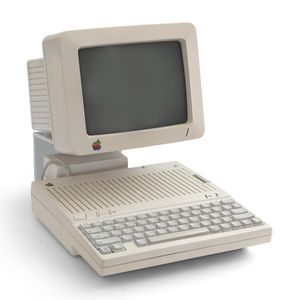Apple II
First launched in 1977, the Apple II was one of the original home computers and the first to offer colour graphics and built-in audio by default.
A 6502 machine, it is noteworthy for a design philosophy in which:
- non-processor actions, such as changing video mode or toggling the speaker, are triggered as a function of address decoding not of hardware registers — e.g. if you access address `C057` then you will set the current graphics mode to 'high resolution' regardless of whether you perform a read or a write, and in the latter case of what you write;
- not even tasks like colour generation are abstracted — the programmer is given a 1bpp pixel output that is in-phase with the NTSC video signal and is expected to generate colours through proper placement of dots; and
- there are zero interrupt sources in an unexpanded machine. There is no way to keep track of time other than processor cycle counting.
Audio
Although the base machine has only a simple binary toggle speaker, all versions of the machine other than the IIc provide expansion slots, allowing a large number of audio options to emerge.
Of those, the Mockingboard has the best game support. Various configurations of the Mockingboard were available with different combinations of AY-3-8910 and Votrax SC-01 (or compatible) speech synthesiser chips, connected via 6522s which also provide timed interrupt sources for the CPU. The best-supported configuration carries two AY-3-8910s and two 6522s.
Some software products even supported more than one Mockingboard. Ultima V supported two boards, for a total of 12 voices, of which it used eight.
Successors
Apple II+
The original machine was followed up by the II+, which includes a better BASIC and can automatically boot from a disk drive if attached.
The II and II+ lack the capacity for lowercase text entry and cannot display lowercase letters in their clean text mode.
Apple IIe
The Apple IIe (styled as Apple //e) is the third model in the Apple II series. It was released in January 1983 as the successor to the Apple II Plus. The e in the name stands for enhanced. It is the first Apple II with built-in lowercase and 80-column text support, as well as 64K RAM, while reducing the total chip count from previous models by approximately 75%.
Apple IIc
The Apple IIc is the fourth model in the Apple II series. It was introduced shortly after the launch of the original Macintosh in 1984. The c in the name stands for compact. It is essentially a remarkably compact version of the Apple IIe. The IIc has a built-in floppy disk drive, and was often sold with its matching monitor.
Apple IIgs
The Apple IIgs is the final model in the Apple II series, equipped with a backwards-compatible 16-bit 65816 CPU. The gs in the name stands for graphics and sound. It is equipped with superior graphics (640x200 in 4 colours, 320x200 in 16 colours, with 4096 colour palette), an high-end Ensoniq 32-voice soundchip, a separate keyboard and mouse, and a Macintosh-like Graphical User Interface.
Links
- Apple II Reference Manuals
- How the Apple II Works! by The 8-Bit Guy
- Over 50 Apple II games in under 30 minutes
- Over 100 Apple IIGS games in under 1 hour
- https://mirrors.apple2.org.za Mirrors popular Apple II file servers

